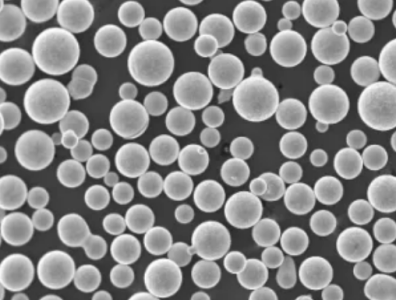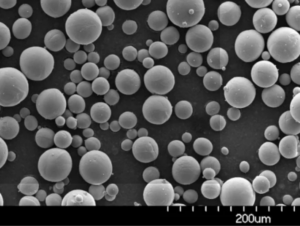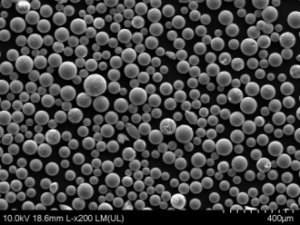316ステンレススチール粉 は、航空宇宙産業からバイオメディカル産業まで幅広い用途を持つ特殊材料です。このガイドでは、316ステンレス鋼粉末の組成、特性、用途、グレード、仕様、価格、長所/短所など、316ステンレス鋼粉末の詳細な概要をご紹介します。
316ステンレス鋼粉末の組成
316ステンレス鋼粉末の元素組成は以下の通りである:
| エレメント | 重量 |
|---|---|
| 鉄(Fe) | バランス |
| クロム(Cr) | 16-18% |
| ニッケル(Ni) | 10-14% |
| モリブデン (Mo) | 2-3% |
| マンガン (Mn) | <2% |
| ケイ素 (Si) | <1% |
| リン (P) | 0.045 |
| 硫黄 (S) | 0.03 |
| カーボン(C) | 0.08 |
| 窒素(N) | 0.1% |
クロムとニッケルの含有量が高いため、316ステンレスの耐食性は高い。モリブデンはこの特性をさらに高めます。粉末組成はASTMの316/316Lグレードの仕様に準拠し、炭素は0.08%未満です。
特性と特徴の概要
316ステンレス鋼粉末は、非常に優れた特性を兼ね備えています:
| プロパティ | 意義 |
|---|---|
| 優れた耐食性 | 様々な化学物質への暴露に耐える耐久性 |
| 抜群の強さ | 高強度部品への焼結が可能 |
| 生体適合性 | 医療機器/インプラントへの使用に対する安全性 |
| 耐熱性 | 高温下でも強度と安定性を維持 |
| 溶接性 | このパウダーで作られた部品は融合しやすい |
| 加工性 | 焼結/+脱脂された部品は、機械加工、穴あけ、タップ加工などが可能。 |
| 磁気 | ニッケル含有によりわずかに磁性がある |
これらの特性により、さまざまな用途や業界で使用することができる。

用途と使用法 316ステンレススチール・パウダー
316ステンレス鋼粉末の代表的な用途には、以下のようなものがある:
| 産業 | 用途 |
|---|---|
| 航空宇宙 | エンジン部品、フィッティング、ファスナー |
| 自動車 | バルブ、粉末冶金部品 |
| 化学処理 | ポンプ、バルブ、タンク、パイプ |
| 石油・ガス | ウェルヘッド、マニホールド、ダウンホールツール |
| バイオメディカル | インプラント、手術器具、機器 |
| 3Dプリンティング | 航空宇宙と自動車のプロトタイプ |
耐食性、強度、加工の多様性により、316ステンレ スは要求の厳しい機械的および構造的用途に有用 である。生体適合性により、医療用途にも使用できる。
316ステンレス鋼粉末の等級と仕様
316ステンレス鋼粉末は標準グレードで入手可能:
| グレード | ASTM仕様 | 備考 |
|---|---|---|
| 316 | A240, A276, A479 | 標準モリブデン含有グレード |
| 316L | A240, A276, A479 | 低炭素変種、より良い溶接 |
人気のあるサイズ分布:
| メッシュ範囲 | ミクロンレンジ |
|---|---|
| -140+325メッシュ | 44~104ミクロン |
| -325メッシュ | 44ミクロン |
ガスアトマイズ粉末と水アトマイズ粉末の両方が一般的です。特注の粒度分布も可能です。
316ステンレスパウダー価格
| ディストリビューター | 価格/Kg |
|---|---|
| アトランティック・エクイップメント・エンジニア | $25 – $60 |
| サンドビック・オスプレイ | $45 – $150 |
| カーペンター・パウダー製品 | $40 – $100 |
| ヘガネス | $30 – $80 |
| カイメラ・インターナショナル | $35 – $90 |
価格は、注文数量、サイズ分布、製造方法(ガス噴霧式か水噴霧式か)、サプライヤーの条件、場所によって異なる。
長所と短所 316ステンレススチール・パウダー
| 長所 | 短所 |
|---|---|
| 優れた耐食性 | 炭素鋼粉末に比べて高価 |
| 高い強度対重量比 | 焼結中に表面酸化が起こることがある |
| 非常に微細な粒子が達成可能 | 焼結の際、良好なベント/雰囲気制御が必要 |
| カスタム合金グレードも可能 | 鉄粉に比べ、グリーンパーツへの圧縮が難しい。 |
| 世界各地のサプライヤー |
コストよりも特性が重視される重要な用途では、316ステンレスパウダーが性能を発揮します。
よくある質問
Q: レーザー焼結AMに最適な316L粉末の粒度は?
A: 一般的には45ミクロン(-325メッシュ)以下が好ましく、D90は35ミクロン以下が理想的である。
Q: 316Lステンレス鋼粉末の一般的なタップ密度はどのくらいですか?
A: 霧化方法と粒度分布から4.0~4.8g/cc。
Q: 焼結後のステンレス粉末は再利用可能ですか?
A: はい、未使用のオーバーサイズのパウダーは、汚染を避けるために適切に取り扱えば、再利用のために引き揚げてふるいにかけることができます。
Q: 316L 粉末は真空または不活性雰囲気での焼結が必要ですか?
A: 表面酸化の影響を防ぐため、焼結中は真空またはアルゴン/窒素雰囲気を推奨する。
結論
耐食性、強度、加工の多様性により、316/316L ステンレス鋼粉末は、生物医学インプラントから航空宇宙部品に至るまで、幅広い用途で選択される材料です。その詳細な組成、特性、仕様、焼結に関する考慮事項を理解することで、エンジニアはこの材料の利点を活用することができます。

